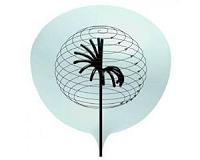 |
Hoboken NJ (SPX) May 25, 2011 A Biomedical Engineering Senior Design team at Stevens Institute of Technology is working with the U.S. Army and New Jersey physicians to develop a new device to combat hypothermia among wounded soldiers. Team "Heat Wave" is composed of seniors Walter Galvez, Amanda Mendez, Geoffrey Ng, and Dalia Shendi, in addition to Biomedical Engineering graduate student Maia Hadidi. The team's faculty advisor is Dr. Vikki Hazelwood and consulting physician is Dr. Herman Morchel from Hackensack University Medical Center. Additional expert support from industry and military was provided by Jan Skadberg, RN, Colonel Boots Hodges, Stevens Burrows, and Major Jim Fulton. "Stevens unique Senior Design approach gave students real-world experience developing a practical technology in collaboration with the military," says Dr. Hazelwood. "This is a fantastic project with a life-saving application as well as entrepreneurial potential." Developing a portable device to re-warm patients suffering from hypothermia has the potential to substantially impact battlefield medicine. Loss of blood after trauma is the number one cause of combat fatalities in the United States armed forces. Hypothermia complications associated with loss of blood are shown to reduce the rate of survival after severe trauma by 22.5%. "Current methods for fighting hypothermia in combat zones are to use an IV drip and wool blanket," says Geoffrey. "With these means it takes up to 16 hours to increase the core body temperature to a more stable point." The Heat Wave system uses heated, humidified air delivered through an oxygen mask to capitalize on the patient's respiratory system. Capitalizing on the fact that the entire blood volume passes through the lungs, this heat is rapidly transferred to the blood via convection. Tests of their system show it is more effective than current treatments. "We can decrease the time needed to resuscitate a hypothermic patient to just four hours, a 75% reduction in treatment time," reports Maia. "Not only does this increase survival rates for the patient, but it also frees up field medics so they can attend to others." The team developed a prototype to test their concept. A heater/humidifier pumps air into an insulated container simulating the lungs, which is connected to an additional container representing the cardiovascular system. Heat transfers between the containers via a water-filled tube to simulate convection between lungs and blood. Heat and humidity are continually recorded via sensors wired to a laptop computer. "The hands-on Senior Design process is very helpful," Dalia says. "Before Stevens, I had little real experience, and now I know I can research a problem, look at the market for a product, and build and test a successful prototype." In addition to presenting their research at Senior Projects Expo April 27, the team is participating in the Student Elevator Pitch competition during Research and Entrepreneurship Day on April 29. "Now that we have proof of concept, we want to pass this idea to someone who can make it into a portable device viable for field treatment," Amanda says. "Not only is it a life-saving product, but it also has great market potential," says Geoffrey, who is representing the team for the elevator pitch. "The Heat Wave system does not replace current treatments, but is used in parallel, so it has no direct competition." The students report tremendous satisfaction knowing that their invention will save lives. Contributions like this are a constant fixture for biomedical engineers, a fact that has helped make careers in Biomedical Engineering one of the top-rated in the United States. "We all felt that this project offered us a unique opportunity," Walter recalls. "We were able to collaborate with the military to save the lives of our soldiers."
Share This Article With Planet Earth
Related Links Stevens Institute of Technology Hospital and Medical News at InternDaily.com
 Digital imaging software to create a 'Google Earth' view of the bladder
Digital imaging software to create a 'Google Earth' view of the bladderSeattle CA (SPX) May 23, 2011 Bladder cancer is the fourth-most-common cancer in men and one of the most expensive cancers to treat from diagnosis to death. After initial diagnosis and surgery, patients must return to the urologist at least yearly for a costly, time-consuming and uncomfortable bladder scan. Tumors recur in more than half of patients. Researchers at the University of Washington are proposing a more auto ... read more |
|
| The content herein, unless otherwise known to be public domain, are Copyright 1995-2010 - SpaceDaily. AFP and UPI Wire Stories are copyright Agence France-Presse and United Press International. ESA Portal Reports are copyright European Space Agency. All NASA sourced material is public domain. Additional copyrights may apply in whole or part to other bona fide parties. Advertising does not imply endorsement,agreement or approval of any opinions, statements or information provided by SpaceDaily on any Web page published or hosted by SpaceDaily. Privacy Statement |